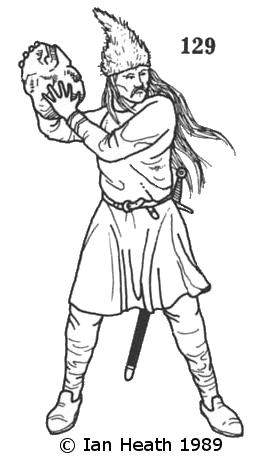
Find the perfect fit with Amazon Prime. Try Before You Buy.
VLACH INFANTRYMAN
An extract from Armies of Feudal Europe 1066-1300by Ian Heath



129. VLACH INFANTRYMAN
Seemingly descendants of Romanised Thracian and Illyrian tribes, the Vlachoi or Wallachians are first recorded c.976 in Cedrenus' 11th century 'Chronicle', at which time they lived predominantly south of the Danube and were described as nomadic herdsmen and footpads'. Even in the 12th century Anna Comnena still describes them as nomads and in 1160 the traveller Benjamin of Tudela refers to their brigandage; nevertheless, by the beginning of the 13th century many had begun to settle as farmers north of the Danube in the territory that was to become Wallachia, while others leant their energies to the establishment of the Second Bulgarian Empire in alliance with the Bulgarians and Cumans.
This particular figure comes from a 14th century depiction of the Battle of Posada in 1330, where an Hungarian army was ambushed by the Wallachians in a mountain pass and subjected to a hail of stones and arrows from above. This was clearly a traditional Vlach tactic since Emperor Isaac II Angelus was similarly heavily defeated in a narrow pass in 1191, the Vlachs hurling stones down on his troops and simultaneously attacking from ground level, inflicting severe losses on the Byzantines. The figure depicted wears a red tunic, a pointed fur or sheepskin cap, and trousers tight at the ankles; others wore fur or sheepskin coats too (see figure 75 in Armies of the Middle Ages, volume 2). Note the length of his black or dark brown hair, a fashion that was probably adopted under Pecheneg or Cuman influence. (It seems likely that by the 11th century the Vlachs included a large Pecheneg element, while by the end of this era the Hungarians were using the terms 'Wallachian' and 'Cuman' interchangeably.) The majority of Vlachs appear to have been archers, whether on horse or on foot, with sword, sabre or mace for secondary armament.